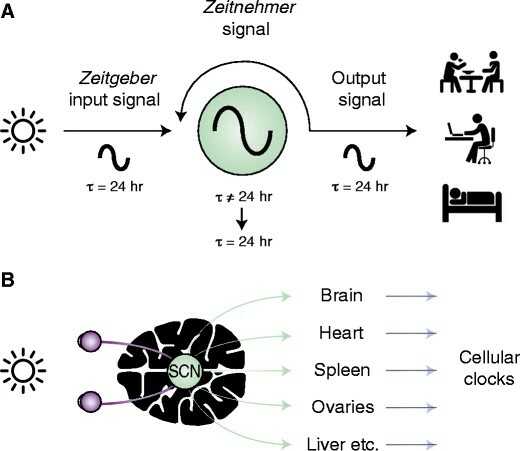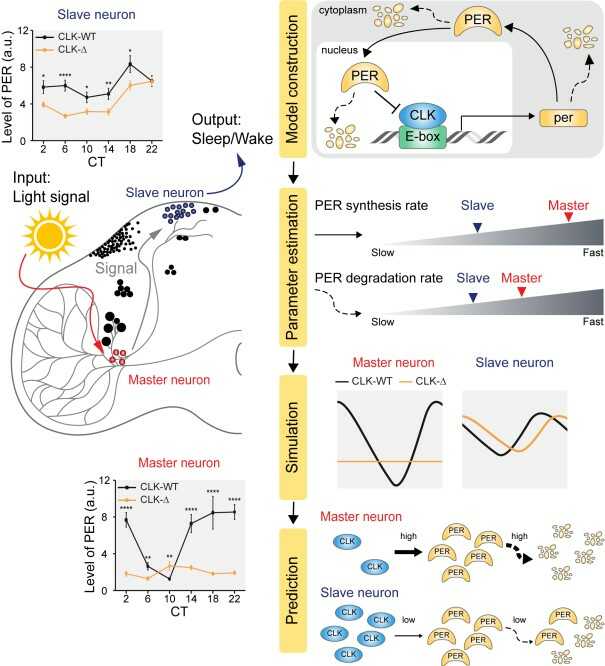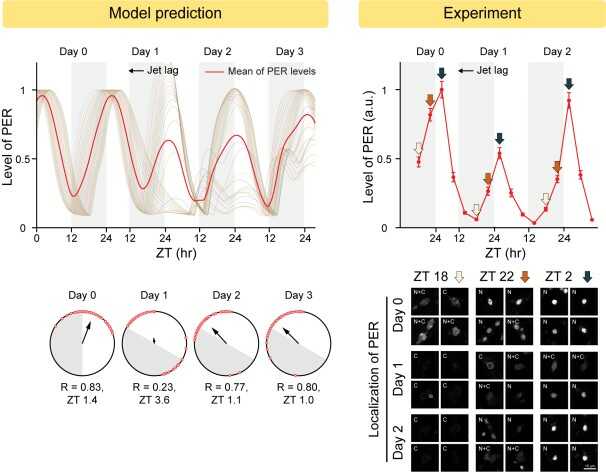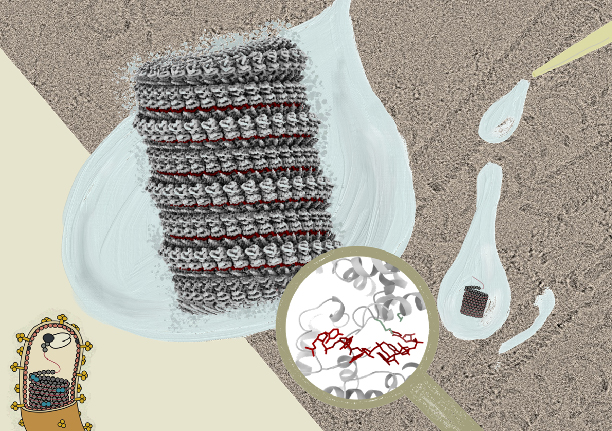コンピューターモデリングと動物実験の組み合わせにより、マスターとスレーブの発振器が異なる分子メカニズムで機能していることが明らかになった
Combination of computer modeling and animal experiments reveal that master and slave oscillators function via different molecular mechanisms
2022-01-10 大韓民国・基礎科学研究院(IBS)
From tiny fruit flies to human beings, all animals on Earth maintain their daily rhythms based on their internal circadian clock. The circadian clock enables organisms to undergo rhythmic changes in behavior and physiology based on a 24-hour circadian cycle. For example, our own biological clock tells our brain to release melatonin, a sleep-inducing hormone, at night time.
The discovery of the molecular mechanism of the circadian clock was bestowed The Nobel Prize in Physiology or Medicine 2017. From what we know, no one centralized clock is responsible for our circadian cycles. Instead, it operates in a hierarchical network where there are “master pacemaker” and “slave oscillator”.
The master pacemaker receives various input signals from the environment such as light. The master then drives the slave oscillator that regulates various outputs such as sleep, feeding, and metabolism. Despite the different roles of the pacemaker neurons, they are known to share common molecular mechanisms that are well conserved in all lifeforms. For example, interlocked systems of multiple transcriptional-translational feedback loops (TTFLs) composed of core clock proteins have been deeply studied in fruit flies.
However, there is still much that we need to learn about our own biological clock. The hierarchically-organized nature of master and slave clock neurons leads to a prevailing belief that they share an identical molecular clockwork. At the same time, the different roles they serve in regulating bodily rhythms also raise the question of whether they might function under different molecular clockworks.
Led by Prof. KIM Jae Kyoung and KIM Eun Young, researchers at the Institute for Basic Science (IBS) and Ajou University used a combination of mathematical and experimental approaches using fruit flies to answer this question. The team found that the master clock and the slave clock operate via different molecular mechanisms.
In both master and slave neurons of fruit flies, a circadian rhythm-related protein called PER is produced and degraded at different rates depending on the time of the day. Previously, the team found that the master clock neuron (sLNvs) and the slave clock neuron (DN1ps) have different profiles of PER in wild-type and Clk-Δ mutant Drosophila. This hinted that there might be a potential difference in molecular clockworks between the master and slave clock neurons.
However, due to the complexity of the molecular clockwork, it was challenging to identify the source of such differences. Thus, the team developed a mathematical model describing the molecular clockworks of the master and slave clocks. Then, all possible molecular differences between the master and slave clock neurons were systematically investigated by using computer simulations. The model predicted that PER is more efficiently produced and then rapidly degraded in the master clock compared to the slave clock neurons. This prediction was then confirmed by the follow-up experiments using animal.
Then, why do the master clock neurons have such different molecular properties from the slave clock neurons? To answer this question, the research team again used the combination of mathematical model simulation and experiments. It was found that the faster rate of synthesis of PER in the master clock neurons allows them to generate synchronized rhythms with a high level of amplitude. Generation of such a strong rhythm with high amplitude is critical to delivering clear signals to slave clock neurons.
However, such strong rhythms would typically be unfavorable when it comes to adapting to environmental changes. These include natural causes such as different daylight hours across summer and winter seasons, up to more extreme artificial cases such as jet lag that occurs after international travel. Thanks to the distinct property of the master clock neurons, it is able to undergo phase dispersion when the standard light-dark cycle is disrupted, drastically reducing the level of PER. The master clock neurons can then easily adapt to the new diurnal cycle. Our master pacemaker’s plasticity explains how we can quickly adjust to the new time zones after international flights after just a brief period of jet lag.
It is hoped that the findings of this study can have future clinical implications when it comes to treating various disorders that affect our circadian rhythm. Chief investigator Kim notes, “When the circadian clock loses its robustness and flexibility, the circadian rhythms sleep disorders can occur. As this study identifies the molecular mechanism that generates robustness and flexibility of the circadian clock, it can facilitate the identification of the cause of and treatment strategy for the circadian rhythm sleep disorders.”

Figure 1. General structure of the circadian clock. (From Violetta Pilorz, Charlotte Förster, Henrik Oster, Pflugers Arch – Eur J Physiol (2018))

Figure 2. (left) The circadian clock operates as a network where the master pacemaker and slave oscillator are organized in a hierarchical manner. Although they generate rhythms via an identical transcriptional-translational feedback loop (TTFL) of PER proteins, the generated PER rhythms are different between them. (right) By using a mathematical model describing the TTFL of the Drosophila circadian clock (top), we identified the differences between master and slave clock neurons (bottom).

Figure 3. The combination of mathematical model simulations and experiments found how the master clock neurons can obtain both robustness (i.e., high amplitude and period robustness) and plasticity (i.e., fast entrainment and a wide range of entrainment). (left) The model predicts that when jet lag occurs, the master clock neurons dispersed the phase of rhythms, reducing the amplitude of rhythms. This leads to the rapid adaption to the new time zone. (right) This model prediction was confirmed by the follow-up experiments.
Notes for editors
– References
Eui Min Jeong, Miri Kwon, Eunjoo Cho, Sang Hyuk Lee, Hyun Kim, Eun Young Kim, and Jae Kyoung Kim, Systematic modeling-driven experiments identify distinct molecular clockworks underlying hierarchically organized pacemaker neurons, PNAS (2022).
– Media Contact
For further information or to request media assistance, please contact Jae Kyoung Kim at Biomedical Mathematics Group, Institute for Basic Science (IBS) (jaekkim@ibs.re.kr) or William I. Suh at the IBS Communications Team (willisuh@ibs.re.kr)
– About the Institute for Basic Science (IBS)
IBS was founded in 2011 by the government of the Republic of Korea with the sole purpose of driving forward the development of basic science in South Korea. IBS has 1 research institute and 31 research centers as of January 2022. There are ten physics, three mathematics, seven chemistry, five life science, one Earth science, and five interdisciplinary research centers.


